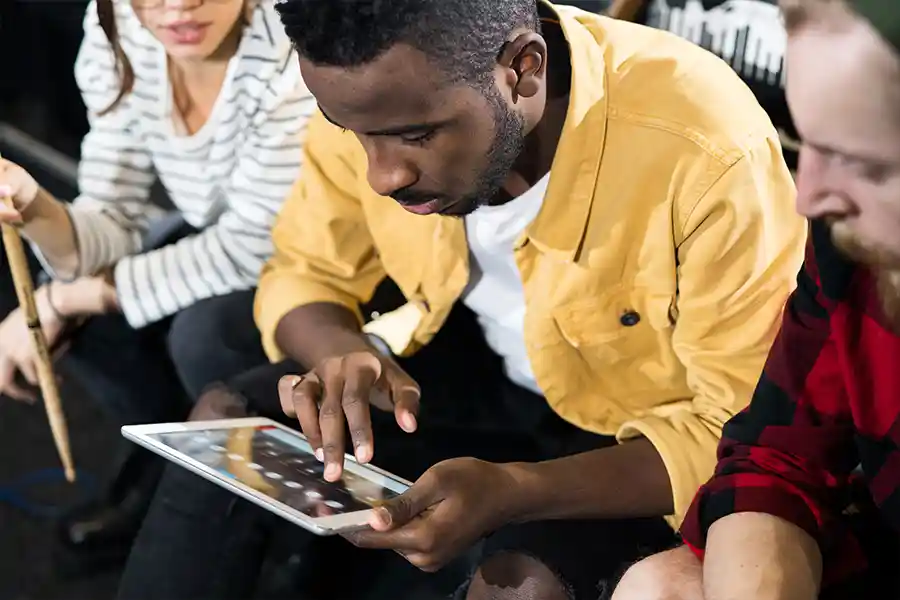For startups aiming to stand out without breaking the bank, understanding emerging web design trends is crucial. The pace of change is staggering, with three new websites popping up every second, equating to a remarkable 252,000 new websites each day. Affordable web design for small businesses is not just about cutting costs—it’s about leveraging innovation to create engaging and efficient digital spaces. Let’s explore the web design trends set to shape 2025.
Affordable Web Design for Small Businesses: Emphasis on User Experience and Accessibility
User experience (UX) and accessibility are essential pillars of modern web design. A seamless experience keeps visitors on your site, and accessibility ensures that everyone, regardless of ability, can interact with your content. Even a single-second delay in page load time can cause conversion rates to plummet by 7%. Moreover, a staggering 57% of users will abandon a website if it takes longer than three seconds to load.
For startups, creating a fast and user-friendly site is not just nice to have—it’s a must. Streamlined navigation, intuitive layouts, and quick load times make a significant difference in keeping visitors engaged. Plus, an accessible site broadens your audience reach, ensuring no one is left out. Simple tweaks like alt text for images and keyboard-friendly navigation can make a world of difference. Ensuring your site is both user-friendly and accessible not only improves visitor retention but also builds trust and credibility, crucial for any startup looking to make its mark.

The Rise of AI and Personalisation
Artificial Intelligence (AI) is changing the game in web design, making personalisation more achievable and efficient. Nearly half of design professionals, about 47%, anticipate AI will significantly impact their work in the coming years. By taking over repetitive tasks and providing data-driven insights, AI solutions can trim design costs by around 20%. For startups, integrating AI into their web design strategy can lead to more personalised user experiences, enhancing both engagement and satisfaction.
AI can tailor content to individual users based on their behaviour, preferences, and history, making each visit to your website feel unique. This level of personalisation helps to build a stronger connection with your audience, keeping them engaged and encouraging return visits. Additionally, AI-driven chatbots can provide real-time support, improving customer service without the need for a large team. As AI technology continues to evolve, its role in web design is only set to grow, offering even more innovative ways to connect with your audience and optimise your site.
Affordable Web Design for Small Businesses: Mobile-First Design Becomes Non-Negotiable
Mobile internet usage is skyrocketing, making mobile-first design an absolute must. No longer can businesses afford to treat mobile optimisation as an afterthought. For startups, this means ensuring your website is not only accessible on smaller screens but also fully functional and user-friendly. A clunky, hard-to-navigate mobile site can turn away potential customers in seconds. Prioritising mobile design involves more than just shrinking down your desktop site; it requires a thoughtful approach to layout, navigation, and load times tailored to mobile users.
In a world where people increasingly browse, shop, and interact via their smartphones, your site needs to perform seamlessly on these devices. Features like thumb-friendly buttons, responsive images, and simplified menus can make a world of difference in user experience. It’s about creating a smooth, intuitive journey from the moment a visitor lands on your site to the point they take action, whether that’s making a purchase, signing up for a newsletter, or contacting your team.
For startups, embracing mobile-first design is about staying relevant and competitive. Ignoring this trend could mean missing out on a massive segment of users who rely on their phones for almost everything. By focusing on mobile-first design, you’re not just keeping up with the times—you’re setting your business up for success in an increasingly mobile-centric world.

Sustainable and Eco-Friendly Web Design
Sustainability is becoming a significant consideration in web design as businesses aim to reduce their digital carbon footprints. This means creating websites that load quickly and require less data transfer, which not only helps the planet but also improves user experience. For startups, adopting eco-friendly design practices can be a smart move. It appeals to environmentally conscious consumers and shows that your business cares about more than just profits. Techniques like optimising images, using efficient coding practices, and selecting green hosting providers can make a big difference. These changes not only make your site greener but also more efficient and cost-effective. By focusing on sustainable web design, startups can create high-performing websites that are kinder to the environment, while also appealing to a growing segment of eco-aware customers.
Integration of Augmented Reality (AR)
Augmented Reality (AR) is revolutionising the way users engage with websites, offering a more immersive experience that blends the digital with the physical. An impressive 71% of consumers report they would shop more frequently if AR were an option. For startups, incorporating AR can set you apart from the competition, providing unique features that attract and retain customers.
Imagine a potential customer being able to see how a piece of furniture would look in their living room before purchasing it, or trying on clothes virtually. These AR capabilities can significantly enhance the user experience, making online shopping not just convenient but also enjoyable. The technology is becoming more accessible, making it easier for smaller businesses to implement AR without a massive investment.
Beyond retail, AR can be utilised in various sectors—think interactive product demos, virtual tours, and even educational content. By integrating AR, startups can create engaging, memorable experiences that keep users coming back. As AR technology continues to evolve, its potential to enrich digital interactions will only grow, offering innovative ways for startups to connect with their audiences.

Affordable Web Design for Small Businesses: Minimalist and Clean Aesthetic
Minimalism in web design is all about stripping away the unnecessary to let your content shine. It’s about using clean lines, ample white space, and simple, intuitive navigation that guides visitors effortlessly. This approach not only looks sleek and professional but also enhances usability, making it easier for users to find what they need without distraction.
Research shows that 75% of people associate a website’s credibility with its design. In a world where first impressions matter, a clutter-free, visually appealing website can be a game-changer for startups. It’s about creating a space that feels both welcoming and trustworthy.
Additionally, research by Adobe shows that 38% of users will disengage from a website if its content or layout is unattractive. This highlights the importance of a clean and appealing design, which can keep visitors engaged and reduce bounce rates.
Minimalist design isn’t just about aesthetics; it’s also about performance. With fewer elements to load, minimalist websites often perform better and load faster, enhancing the overall user experience. This is particularly crucial for mobile users who may be on slower connections.
For startups, adopting a minimalist and clean aesthetic can set you apart in a crowded market. It signals professionalism and attention to detail, helping to build a positive perception of your brand from the get-go.
Affordable Web Design for Small Businesses: Focus on High-Quality Content
Let’s be honest, no matter how flashy your website looks, it’s the content that keeps people coming back. Quality content is the backbone of any successful site. It’s not just about filling up space with words but offering something of real value. High-quality content means well-researched articles, engaging blog posts, and compelling copy that resonates with your audience.
Search engines are getting smarter and are prioritising content that’s relevant and useful. For startups, this means your content strategy should focus on providing insights, solutions, or entertainment that meets your audience’s needs. It’s about crafting stories that connect, answering questions your potential customers might have, and presenting information in a clear, engaging manner.
Don’t underestimate the power of good copywriting, either. Well-written content not only helps with SEO but also builds credibility and trust. It’s worth investing the time to create content that’s not only informative but also enjoyable to read. This could mean anything from detailed how-to guides and case studies to light-hearted blog posts and customer testimonials.
Remember, it’s not just the written word. High-quality content can also include infographics, videos, and interactive elements that make your site more engaging. The key is to keep it relevant and valuable. By focusing on delivering top-notch content, you’ll not only attract visitors but also keep them coming back for more, building a loyal customer base in the process.

Leveraging Video and Animation
Let’s face it, nothing grabs attention quite like a well-crafted video or a snazzy animation. These elements can breathe life into your website, turning static pages into interactive experiences that captivate visitors. For startups, incorporating video and animation is a fantastic way to showcase your brand’s personality, explain complex ideas, or highlight your products in action.
Think about it: would you rather read a long-winded product description or watch a 30-second video that demonstrates exactly how it works? Most people would choose the latter. Videos can be used for everything from customer testimonials and tutorials to behind-the-scenes glimpses of your business. They create an emotional connection that words alone often can’t achieve.
Animations, on the other hand, can guide users through your site, making navigation intuitive and fun. Simple animations like hover effects and loading icons can improve user experience, making your site feel modern and engaging. And let’s not forget the impact of animated explainer videos, which can break down complex information into digestible, visual snippets.
You don’t need a Hollywood budget to create effective video and animation content. With a bit of creativity and the right tools, startups can produce high-quality visuals that resonate with their audience and enhance their online presence. It’s about working smarter, not harder, to keep your visitors engaged and coming back for more.

Security and Privacy as Core Elements
In today’s digital age, safeguarding your website’s security and privacy is more important than ever. Startups must prioritise these aspects right from the get-go. It’s not just about protecting sensitive customer data; it’s also about building trust with your audience. Imagine the fallout if your customers’ information were compromised—it’s a nightmare scenario that could damage your reputation beyond repair.
So, how can startups ensure robust security and privacy? Start with the basics: implement SSL certificates to encrypt data and protect your site from unauthorised access. Regularly update your software to patch vulnerabilities and consider using security plugins for added layers of protection. It’s also crucial to educate your team about best practices for data handling and password management.
Transparent privacy policies are another must-have. Clearly outline how user data is collected, used, and stored. This not only complies with regulations but also reassures your customers that their information is in safe hands.
By making security and privacy core elements of your web design strategy, you not only safeguard your business but also foster a trustworthy relationship with your users. It’s a win-win situation that can set your startup on the path to success.
Affordable Web Design for Small Business
Let’s face it, not every startup has the budget to splash out on a top-tier web design agency. The good news is, you don’t need a massive budget to create a professional, effective website. Affordable web design for small businesses has come a long way, with plenty of companies offering cost-effective solutions tailored to smaller budgets. The key is to find a service that understands your needs and can deliver quality without the hefty price tag.
Many affordable website design companies now utilise template-based designs and open-source platforms like WordPress, which can significantly cut down on development time and costs. These options are not only budget-friendly but also highly customisable, allowing you to create a unique digital presence that reflects your brand. Moreover, many of these services offer scalable solutions, so as your business grows, your website can easily be upgraded to meet new demands.
You don’t have to sacrifice quality for affordability. By doing a bit of research and choosing the right partners, you can get a website that looks great, functions smoothly, and doesn’t break the bank. Remember, it’s all about finding the right balance between cost and quality to set your business up for success.